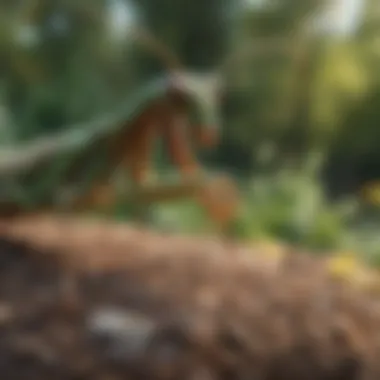Praying Mantis Pest Control in Prescott, AZ


Intro
Praying mantises serve as valuable allies in pest management, especially in areas like Prescott, Arizona. Their predatory nature helps control populations of common garden pests, making them an essential component of natural pest control strategies. Understanding the biology and behavior of these insects will enable homeowners to maximize their benefits while maintaining ecological balance.
As we delve deeper into the intricacies of using praying mantises for pest management, it becomes paramount to identify the specific pests that often challenge homeowners. Many individuals remain unaware of the signs of infestation, which can lead to larger issues if not addressed promptly. We will explore various household pests commonly found in Prescott and discuss how praying mantises contribute to managing these populations effectively.
Pest Identification
Common Household Pests
In Prescott, several pests may plague gardens and outdoor spaces. Among these, aphids rank high due to their rapid reproduction cycle and the damage they inflict on plants. Other pests include:
- Spider mites
- Whiteflies
- Caterpillars
- Stink bugs
These pests not only harm the plants but can also disrupt the overall gardening ecosystem. Praying mantises target these pests, providing a natural solution for control.
Signs of Infestation
Recognizing the signs of pest infestation is crucial for effective intervention. Some indicators include:
- Wilting or yellowing leaves
- Visible pests on leaves and stems
- Sticky residue on plants, known as honeydew
- Webbing on foliage, indicative of spider mites
Identifying these signs early allows homeowners to determine the best course of action before the problem escalates.
The Role of Praying Mantises
Praying mantises are carnivorous insects known for their unique hunting capabilities. With their ability to consume large quantities of pests, they provide numerous benefits, including:
- Reduced reliance on chemical pesticides
- Contribution to biodiversity in the garden
- Maintenance of natural predator-prey relationships
When mantises are present, they instinctively seek out and consume common pests. This natural approach to pest control supports ecological balance and promotes plant health.
Understanding the Praying Mantis
In order to appreciate the role of the praying mantis in pest control, it is vital to understand the underlying aspects of its biology, behavior, and ecological significance. The praying mantis, known for its unique appearance and predatory skills, is a fascinating insect that can be beneficial for gardens. By grasping the fundamental characteristics of mantises, homeowners in Prescott, Arizona can make informed decisions about integrating them into their pest management strategies.
Biology and Life Cycle
Praying mantises belong to the order Mantodea. They exhibit a complex life cycle that includes three main stages: egg, nymph, and adult. The adult mantis typically lives for around 6 months to a year, depending on its species and environmental conditions. Here's a closer look at their life cycle:
- Egg Stage: Female mantises lay eggs in a protective foam-like structure called an ootheca. This structure can contain dozens to hundreds of eggs and serves as a safeguard against predators.
- Nymph Stage: Upon hatching, nymphs resemble miniature adults but lack fully developed wings. They undergo several molts, growing larger with each stage until they reach adulthood.
- Adult Stage: Fully grown mantises display distinct characteristics, such as their large compound eyes and grasping forelegs, which make them adept hunters.
Understanding this lifecycle can help homeowners identify the best times to expect mantises in their gardens, as well as when to manage populations effectively.
Habitat and Distribution
Praying mantises thrive in diverse habitats, ranging from gardens, meadows to forest edges. They prefer areas with ample vegetation, as this provides necessary cover for ambushing prey. In Prescott, Arizona, the local climate supports various species of mantises. Typically, these species are found near flowering plants and shrubs because these environments sustain the insects they prey upon. This distribution is significant as it suggests that planting native vegetation can encourage mantis populations, providing natural pest control solutions.
Identification Features
Being able to identify praying mantises is essential for any homeowner looking to benefit from their presence. Some key identifying features include:
- Body Shape: Mantises have elongated bodies with triangular heads, making them distinct from other insects.
- Coloration: They can vary in color, from green to brown, allowing them to camouflage within their surroundings.
- Forelegs: The forelegs of mantises are spiny and designed for grabbing prey, which is a characteristic feature that can help in their identification.
Keep these characteristics in mind, as correctly identifying mantises can prevent potential confusion with other insect species that may not offer the same benefits.
Understanding the praying mantis provides insight into its ecological role and its contribution to integrated pest management approaches. This knowledge is fundamental for anyone interested in using natural methods to manage pests in gardening.
The Role of Praying Mantises in Pest Control


Praying mantises have emerged as significant allies in pest control, especially within the specific ecosystems of Prescott, Arizona. These insects are not just fascinating creatures but also serve an essential purpose in maintaining the balance in local gardens and landscapes. Understanding their role can help homeowners utilize them effectively in their pest management strategies.
Natural Predators
Praying mantises are well-known as natural predators of various garden pests. They primarily hunt and consume a range of insects, including aphids, caterpillars, and beetles. Their unique structure, combined with excellent vision and lightning-fast reflexes, makes them efficient at capturing prey. As these insects roam through gardens, they help to regulate pest populations, limiting the reliance on chemical pesticides.
Encouraging the presence of mantises can lead to natural pest reduction. Homeowners benefit from their predatory prowess, as mantises can consume a substantial number of pests in a short period. Moreover, by supporting these natural predators, gardeners can foster a healthier environment, contributing to species biodiversity.
Target Pests
Praying mantises are effective against numerous target pests that commonly afflict gardens. Some of the most notable include:
- Aphids: Small, sap-sucking insects that can cause significant damage to plants.
- Caterpillars: Often destructive, these larvae feed on foliage.
- Crickets: While some garden species are acceptable, others can be pests.
- Flies: Many flies pose threats to plants and crops.
- Termites: Although not a garden pest per se, mantises can help in areas where they invade wooden structures.
By preying on these insects, mantises play a vital role in natural pest control, providing an eco-friendly alternative to chemical interventions. This aligns with sustainable gardening practices and a growing interest in organic methods.
Impact on Pest Populations
The impact of praying mantises on pest populations in Prescott, AZ, is substantial. Their presence contributes significantly to pest regulation. Studies indicate that a small number of mantises can reduce pest populations dramatically within a single growing season. As they occupy niches in ecosystems, their predation can lead to increases in overall plant health.
However, it is crucial to understand that while mantises are effective predators, they can also have a complex relationship with other beneficial insects. Praying mantises do not restrict their diet to pests alone; they also consume beneficial species like ladybugs and bees. Therefore, while they can reduce pest numbers, they may also impact the populations of insects that provide positive contributions to the garden environment.
"Utilizing praying mantises involves a balancing act. Understanding their predatory behavior is key to maximizing their benefits while minimizing any negative impacts."
Homeowners in Prescott should consider adopting an integrated pest management approach, taking care to monitor the balance between maintaining pest populations and safeguarding beneficial insects. This holistic view promotes ecological health while establishing an effective pest control strategy.
Praying Mantises in Prescott, AZ
Praying mantises play a crucial role in the pest control landscape of Prescott, AZ. Their presence can significantly affect local gardens and general outdoor environments. Understanding the specific species, their interactions with the ecosystem, and seasonal patterns can enhance gardening strategies for homeowners. This section delves into these aspects, offering insights into how to effectively leverage the benefits of praying mantises.
Local Species of Praying Mantises
In Prescott, several species of praying mantises can be found. The Carolina mantis and the European mantis are among the most common. The Carolina mantis is usually green or brown, adapting well to the native flora. On the other hand, the European mantis is well-known for its distinctive posture and larger size. Understanding these local species helps in recognizing them correctly and applying pest control measures effectively.
Ecosystem Interactions
Praying mantises interact with various elements of the ecosystem. They are not only predators of many pests but also part of the food chain themselves. Birds, small mammals, and even larger insects may prey on them. This complex relationship highlights the role of praying mantises in controlling pest populations, contributing to ecological balance. Homeowners should appreciate that maintaining this balance is vital for an effective pest management routine.
Seasonal Observations
The activity level of praying mantises varies with the seasons. In Prescott, mantises are typically most visible from late spring to early fall. During these months, they can be seen hunting for pests and mating. It is important to observe their patterns and align gardening activities with their peak times. By understanding their seasonal behavior, homeowners can make informed decisions about when to introduce or maintain mantis populations in their gardens.
"Praying mantises can act as both a natural pest control and a fascinating addition to your garden’s biodiversity."
Integrating the knowledge of local species, ecosystem interactions, and seasonal trends can lead to more effective gardening practices. Homeowners in Prescott can benefit greatly from understanding the nuances of their local praying mantis populations.
Benefits of Using Praying Mantises
The inclusion of praying mantises in pest control strategies offers multiple advantages. Their natural predatory behaviors contribute positively to garden ecosystems in significant ways. By understanding the specific benefits, homeowners can make informed decisions about integrating these insects into their gardening practices.
Chemical-Free Pest Control
One of the primary benefits of using praying mantises is their ability to control pest populations without the use of chemical pesticides. This attribute is valuable for homeowners who prefer environmentally friendly gardening methods.
Praying mantises consume a range of common garden pests. They mainly target aphids, beetles, and caterpillars. By reducing these unwanted visitors naturally, mantises help maintain a healthy garden environment. Homeowners can achieve effective pest management while minimizing chemical exposure to their family, pets, and local wildlife. This approach promotes a safer, more appealing gardening experience.
Biodiversity Promotion
Using praying mantises in gardens fosters biodiversity. These insects are not only beneficial predators but also contribute to the overall balance of the ecosystem. Their presence helps control specific pest populations, supporting other beneficial insects alongside them.


Increasing biodiversity has multiple advantages:
- Resilience: A diverse ecosystem is generally more resilient to pests and diseases.
- Food Web Interaction: Praying mantises serve as prey for birds and other insectivorous species, thereby enriching the ecological food web.
- Soil Health: Increased biodiversity can promote healthier soils, leading to better plant growth and long-term garden health.
By enhancing biodiversity, homeowners can enjoy more vibrant gardens and contribute to ecological stability in their local environments.
Sustainability in Gardening
Praying mantises are an excellent option for sustainable gardening practices. By fostering a self-sustaining ecosystem, they provide an alternative to intensive agricultural practices reliant on chemical inputs. The ability of mantises to establish themselves in gardens contributes to a natural balance that can lead to long-term pest management solutions.
For sustainable gardening, maintaining natural habitats encourages mantis populations to thrive.
Consider the following sustainable gardening practices:
- Companion planting: Integrating plants that attract mantises can support a healthier pest control environment.
- Minimizing soil disturbance: This helps preserve the home of beneficial insects.
- Educating oneself about local ecosystem needs: Understanding how to maintain an appropriate environment for mantises allows homeowners to create conditions favorable for both pests and their predators.
In summary, the benefits of integrating praying mantises into pest control strategies are substantial. They offer chemical-free pest management, promote biodiversity, and support sustainable gardening practices. By embracing these practices, homeowners can create healthier and more vibrant gardens.
Strategies for Attracting Praying Mantises
Attracting praying mantises can be a beneficial strategy for maintainig a healthy garden. Their presence in a garden means a natural form of pest control. However, to make your garden more inviting to these fascinating insects, you must consider the right conditions and selections.
Optimal Garden Conditions
Creating optimal garden conditions is crucial for attracting praying mantises. They prefer environments that mimic their natural habitats. Good drainage and sunlight are key factors. Aim for a space that receives at least six hours of direct sunlight daily. Praying mantises thrive in warm conditions, so a sunny location is advantageous.
Soil quality also matters. Using organic compost can improve soil texture and nutrient content, making it more appealing to mantises. Maintaining a varied structure in your garden, with both open spaces and dense foliage, enhances the habitat.
Additionally, avoid overusing pesticides. These chemicals deter mantises and can harm their populations. Instead, opt for more natural pest management methods that support their role as predators.
Plant Selection
Selecting the right plants is essential for attracting praying mantises. They are drawn to gardens that provide shelter and food sources. Incorporating a mix of flowering and perennial plants will create a thriving ecosystem.
Plants like marigolds and celosia attract other insect species that mantises prey on. Tall grasses or shrubs can offer excellent hiding spots, allowing mantises to ambush pests effectively. Native plants are also a great choice as they tend to support local insect populations.
Consider grouping plants together rather than planting in rows. This design creates a more attractive environment for mantises while contributing to the overall biodiversity of your garden.
Creating Shelter
Providing shelter is a crucial step in attracting praying mantises. They need places to hide from predators and harsh weather. Incorporate structures like brush piles, tall grasses, and garden edges to create safe zones.
Additionally, leaving some leaf litter or debris can help mantises find cover. These spaces allow them to rest and reproduce without disturbance.
You can also use specially designed mantis habitats, such as garden stakes or small enclosures that offer protection while allowing mantises to forage freely. This strategy enhances their chances of survival and, in turn, provides better pest control in your garden.
Remember: Attracting praying mantises involves creating a conducive environment that welcomes and nurtures them, leading to a healthier pest management ecosystem.
Considerations and Cautions
When incorporating praying mantises into pest control strategies, it is essential to consider both the possible benefits and the potential drawbacks. Understanding these aspects allows homeowners to make informed decisions that maintain ecological health while managing pest populations effectively.
Impact on Beneficial Insects
Praying mantises are voracious predators. However, their predatory nature can inadvertently affect beneficial insect populations. Many gardeners rely on insects like ladybugs and lacewings, which control pest populations naturally. When praying mantises are introduced, there is a risk they may consume these important species alongside the target pests.
- Measurement of Impact: It's vital to monitor populations closely. If beneficial insects decrease, the balance in the ecosystem can be disrupted.
- Mitigation Strategies: Homeowners should create zones for beneficial insects, perhaps by planting specific flowers that attract them. This can provide a habitat where beneficial insects can thrive, reducing the impact praying mantises may have.
Managing Introduced Species


Introducing non-native species can pose risks to local ecosystems. Praying mantises are sometimes sold as pest control agents, but not all species are suited for every environment. In Prescott, understanding local species versus introduced ones is crucial.
- Identifying Local Species: Homeowners must research which praying mantis species are endemic to Prescott. This assists in choosing the right kind without adding strain on existing populations.
- Regulatory Guidelines: Local guidelines should be reviewed for introducing species to ensure compliance with environmental policies. This can prevent potential ecological consequences that may arise from mismatched species.
Understanding the Balance
Achieving a balance in pest control is the primary objective for any gardener. Praying mantises can serve as an effective tool in this regard, but their role should be well-calibrated with other ecological factors.
- Food Chain Dynamics: Every action can ripple through the food chain. Ensuring that the introduction of praying mantises aligns with existing ecological relationships is vital.
- Seasonal Considerations: The timing of introducing mantises is also important. Their lifecycle should coincide with peak pest populations to be most effective without overexploitating beneficial insects.
"Nature thrives on balance; altering it too much can lead to unforeseen consequences."
Integrating Praying Mantises with Other Pest Control Methods
Integrating praying mantises into pest control strategies offers unique opportunities for enhancing garden health while addressing pest populations effectively. This section highlights the significance of this integration, focusing on various elements that homeowners in Prescott, Arizona, should consider.
Complementary Biodiversity Management
Biodiversity is crucial in creating balanced ecosystems in gardens. Introducing praying mantises can enhance the diversity of natural pest control agents. These mantises not only target harmful insects but also function well alongside other beneficial insects, such as ladybugs and lacewings. By promoting a variety of species, homeowners can create a more resilient garden that can sustain its ecosystem.
For effective biodiversity management:
- Diversify Planting: Include a wide range of plants. This supports different insect populations, creating habitats for both pests and beneficial species.
- Minimize Chemical Use: Avoid pesticides that could harm mantises and beneficial insects. Opt for organic alternatives that are less disruptive to the ecosystem.
- Embrace Native Plants: Choose plants native to Prescott, as they naturally attract local insects and help maintain the local ecological balance.
By fostering biodiversity, gardens are more likely to benefit from natural pest control mechanisms, reducing the reliance on chemical interventions.
Pest Monitoring Techniques
Monitoring is essential in integrated pest management. This ensures that mantises and other predators are effectively controlling pest populations and helps identify when additional methods may be necessary.
Homeowners can employ several pest monitoring techniques:
- Regular Observation: Spend time observing the garden. Check for signs of pest activity and the presence of mantises.
- Trap Placement: Use sticky traps to monitor pest populations and track changes over time. This provides valuable data on pest levels.
- Data Recording: Maintain a pest management diary. Note observations about pest populations and the effectiveness of praying mantises. This will help refine future management strategies.
Educational Resources
In the quest for effective pest control through praying mantises, having access to sound educational resources is crucial. These resources not only provide vital information on how these insects can aid in managing unwanted pests in Prescott gardens, they also guide homeowners on best practices for maintaining a harmonious ecosystem. Educating oneself greatly enhances the opportunity to understand both the benefits and limitations of introducing mantises into local environments.
Local Workshops and Seminars
Engaging in local workshops and seminars offers an interactive platform for homeowners to explore the practical aspects of pest control using praying mantises. This format encourages participants to ask questions and obtain immediate feedback from experts. Attendees can learn about:
- Practical applications of mantises in gardens, such as optimal placement and care requirements.
- Seasonal behaviors, which can highlight when mantises may be most effective in pest control.
Local agricultural extension offices or garden clubs often organize these sessions. They might feature demonstrations or hands-on activities, making the learning process more effective and enjoyable.
Online Resources and Literature
For those unable to attend physical events, online resources provide a wealth of knowledge at one's fingertips. Websites like Wikipedia and Britannica offer detailed information about the biology and ecology of praying mantises. Meanwhile, community forums such as Reddit catalyze discussion among homeowners who share their personal experiences with using praying mantises in pest control.
Combining literature, research papers, and informal blog posts helps expand understanding through diverse perspectives. Homeowners can:
- Access scientific studies to comprehend the benefits of praying mantises in detail.
- Read success stories or challenges faced by others, equipping them with strategies to optimize their gardens.
Equipped with these resources, homeowners can confidently make informed decisions regarding pest control using praying mantises, ensuring they promote a sustainable environment.
The End
In this article, we have explored the multifaceted role of praying mantises in pest control within Prescott, Arizona. The summary of key takeaways serves to reinforce the importance of understanding these unique insects and their impact on local ecosystems.
Praying mantises provide numerous benefits when used as a natural pest control solution. Their predatory nature helps manage populations of unwanted insects, thereby reducing the reliance on chemical pesticides. This process not only fosters a healthier garden environment but also promotes biodiversity. Moreover, maintaining a sustainable approach to gardening with these predators aligns well with modern practices that prioritize ecological health.
However, it is essential to also consider the impact that introducing praying mantises might have on beneficial insects. Understanding this balance allows homeowners and gardeners to maximize benefits while minimizing harm. Integrated pest management techniques combine the strengths of praying mantises with other methods for effective results.
By educating oneself about local species and the seasonal dynamics at play in Prescott, individuals can make informed decisions about how to incorporate praying mantises into their garden management strategies. Such knowledge is crucial for achieving sustainable gardening practices that cultivate resilience in plants and ecosystems alike.
"Using natural predators like praying mantises can transform pest control into a more harmonious practice with nature."















